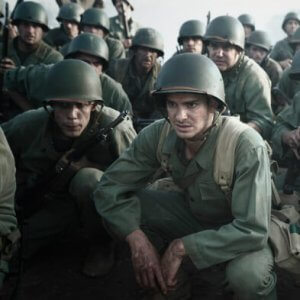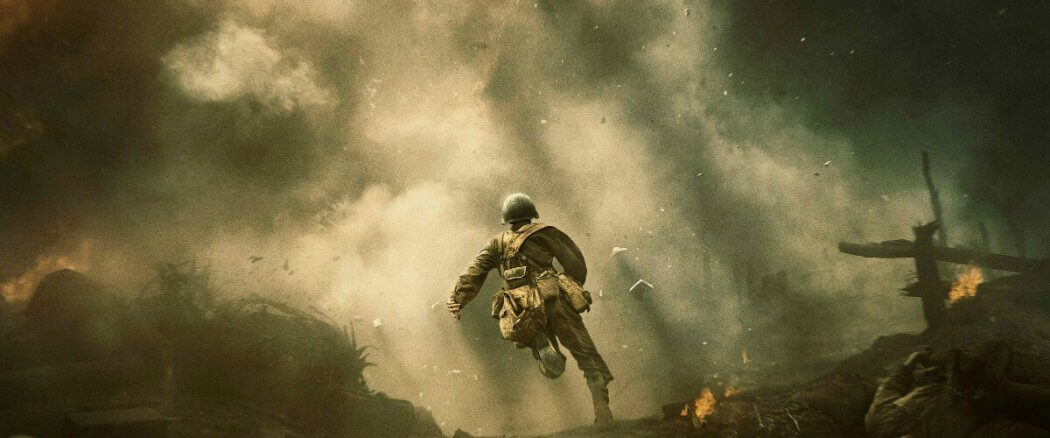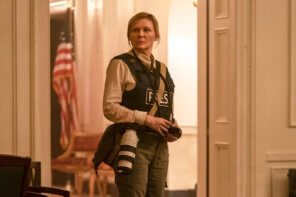Sometimes it’s easy to wonder if Mel Gibson wants to find redemption in his work as a filmmaker. Gibson’s shortcomings are clearly documented: some will tell you he’s a drunk, an anti-Semite and a clinically insane person. Others will tell you he’s a broken man seeking to honor God in his craft. And I think most reasonable people would admit those two extremes aren’t as much a binary as they are endpoints of a spectrum.
Gibson’s work has always focused on heroic, fractured figures. William Wallace and Benjamin Martin were spurred by a curious mingling of revenge and love of fellow men; Jesus was spurred by an unshakeable calling; and Desmond Doss was spurred by beliefs that he doesn’t always understand, but are still deeply melded with his sense of humanity. All these men are broken at one point or another in their respective films, but their commonality is that they live on in one way or another — sometimes literally, and sometimes metaphorically. It’s a fitting picture of Mel Gibson’s career: a heroic figure once, fractured by the world around him, seeking redemption in his work. And if Hacksaw Ridge — his most brutal film to date — is any indication, that redemption has been — and may still be — a long, painful process.
A Curious Faith
Desmond Doss is far from Gibson’s most interesting protagonist. Wallace had a wild charisma about him, while Jesus’ stern perseverance in the face of death literally spawned a religion. But Doss is just your ho-hum American boy. He fights with his brother, scurries up hills, loves his mama, and falls head over heels for a pretty girl in his hometown. It’s fitting his company mates take to categorizing him with Midwest nicknames: beanstalk, cornstalk, hillbilly, etc. By all accounts, Desmond Doss is not a particularly interesting character. Even his faith, vaguely shared by the people around him, isn’t too out of the ordinary.
 But Desmond’s commitment to the Sixth Commandment (“Thou shalt not kill”) is. It’s one that Christians have grappled over for centuries, and the argument changes as we progress as a culture. It’s certainly no mistake that the frame of reference for Desmond’s beliefs is that of a standard issue semi-automatic rifle. And throughout the film, he’s attacked from every possible angle. Still, his faith holds… but just barely. One of Gibson’s saving graces in Hacksaw Ridge is the subtle, unflinching way he addresses doubt. Doss doesn’t show many cracks in his armor, but they are there: when he’s rotting away in a prison cell, charged with the on-the-spot crimes; when he’s staring down at the face of a fallen friend in battle surrounded by forces determined to stop his breath and indifferent to his commitment to life; when he has the barrel of a gun at his father’s forehead, both of them itching for the trigger to be pulled. These moments round out Desmond’s staunch beliefs, giving them a firm foundation in reality. And Andrew Garfield plays them beautifully, a look of loneliness and confusion in his eyes.
But Desmond’s commitment to the Sixth Commandment (“Thou shalt not kill”) is. It’s one that Christians have grappled over for centuries, and the argument changes as we progress as a culture. It’s certainly no mistake that the frame of reference for Desmond’s beliefs is that of a standard issue semi-automatic rifle. And throughout the film, he’s attacked from every possible angle. Still, his faith holds… but just barely. One of Gibson’s saving graces in Hacksaw Ridge is the subtle, unflinching way he addresses doubt. Doss doesn’t show many cracks in his armor, but they are there: when he’s rotting away in a prison cell, charged with the on-the-spot crimes; when he’s staring down at the face of a fallen friend in battle surrounded by forces determined to stop his breath and indifferent to his commitment to life; when he has the barrel of a gun at his father’s forehead, both of them itching for the trigger to be pulled. These moments round out Desmond’s staunch beliefs, giving them a firm foundation in reality. And Andrew Garfield plays them beautifully, a look of loneliness and confusion in his eyes.
And still, he does not grow weary. Faith has become a hallmark of Mel Gibson’s work, and it’s one he’s well-equipped to address. It’s a messy, contradictory topic, especially when we consider the inherent flaws of a sinful humanity.
For God? Or For Country?
While themes of belief, doubt and pacifism are more directly addressed, Hacksaw Ridge also raises questions about the nature of patriotism. There’s a telling line from Sam Worthington’s Captain Glover half way through the film: “The US Army doesn’t make mistakes.” Similarly, Japanese soldiers are portrayed as savages, screaming their way through battle, executing suicide missions and honor killings. And while an argument could be made against this questionably problematic portrayal, the subtleties of American nationalism are everywhere.
 The military in Hacksaw Ridge claims to honor Desmond’s right as a conscientious objector, yet seems determined to ship him away should he choose not to become a killing machine. It’s a trope in war movies, but rifles are portrayed as “lovers” and companions — the shades of Full Metal Jacket a bit too obvious at times. And — more poignantly — older soldiers are cast off, left to wash themselves of the horrors of war in any way they can, namely suicide, alcohol and abuse.
The military in Hacksaw Ridge claims to honor Desmond’s right as a conscientious objector, yet seems determined to ship him away should he choose not to become a killing machine. It’s a trope in war movies, but rifles are portrayed as “lovers” and companions — the shades of Full Metal Jacket a bit too obvious at times. And — more poignantly — older soldiers are cast off, left to wash themselves of the horrors of war in any way they can, namely suicide, alcohol and abuse.
So how does Desmond justify his service in the face of this soft nationalism? Of course, he’s fighting for his country. But his commitment to humanity is important. He’s always clear in his desire to serve those around him by going to war. Doss is an idealist, yes, but one not beholden to any one nation or man, save the God he serves. It effectively raises the question: who and what do we fight for? The passed-down ideas of a glorious empire? Or the good of our neighbor? Desmond addresses it head on when he states the second commandment that Christ gave: “Love your neighbor as yourself.” And while Hacksaw Ridge doesn’t draw any firm conclusions — save the one Desmond comes to — the film does give a picture of what both types of service look like.
The Reality of Violence
Gibson has never shied away from violence in his work, but this time he frames it in a more effective way than ever before. Obviously, Desmond objects to the taking of another man’s life, and usually doesn’t resort to violence to solve his problems: moments in the barracks reaffirm that commitment. And it’s that idea — driven into the audience’s mind for the first half of the film — that makes Gibson’s direction so effective. The violence at Hacksaw Ridge is both graceful and overtly nauseating. Each wide or medium shot of a bullet piercing a man’s heart is counteracted by a tight shot of someone watching a friend, often with gory results. Each death forces the viewer to confront the nature of battle head on. It’s not a spectacle, but often a picture of finality. Desmond recognizes this, and he seems to be the only one. Even his commanding officers seem to struggle with this in the heart of battle. Again, there are no firm conclusions drawn. But as it often is, the question is more important than the answer.
Beyond Hacksaw Ridge
So if Gibson’s portrayal of violence, death, and the cinematic picture of Hacksaw Ridge is so effective, what about his picture of life beyond war? That’s where things get murky. Desmond is a well-defined character, but it comes at the expense of just about everyone around him. Teresa Palmer gives an admirable effort as Dorothy Doss, but it’s hard to make an impression when the total arc of her story is “meet Desmond, fall in love, cry when he’s sent off to war.” Desmond’s brother and mother, both instrumental to his belief system, are barely given more than a few minutes screen time. Desmond’s father (Hugo Weaving) factors in heavily, but only ever serves as a cautionary figure. Desmond’s company mates are given more to do, but no one outside of Smitty (Luke Bracey) ever comes across as a fully-rounded person. These gaps in character work well enough to give Desmond more life, but it becomes problematic during battle. The violence packs a punch based on its own grotesque nature, but death lacks heft when you don’t particularly care for the people who are dying.
All of these themes are sure to come up in post-Hacksaw Ridge Gibson films. He’s been dealing with the same issues for two decades, and that’s not likely to change. But there’s evidence Gibson is growing as an artist. In a way he’s the same guy who took home Oscar gold for Braveheart. But his renewed commitment to the contextual questions of violence, as well as his subtle critiques of American exceptionalism, point to greater, deeper films in the future. For now though, Hacksaw Ridge will do just fine.





